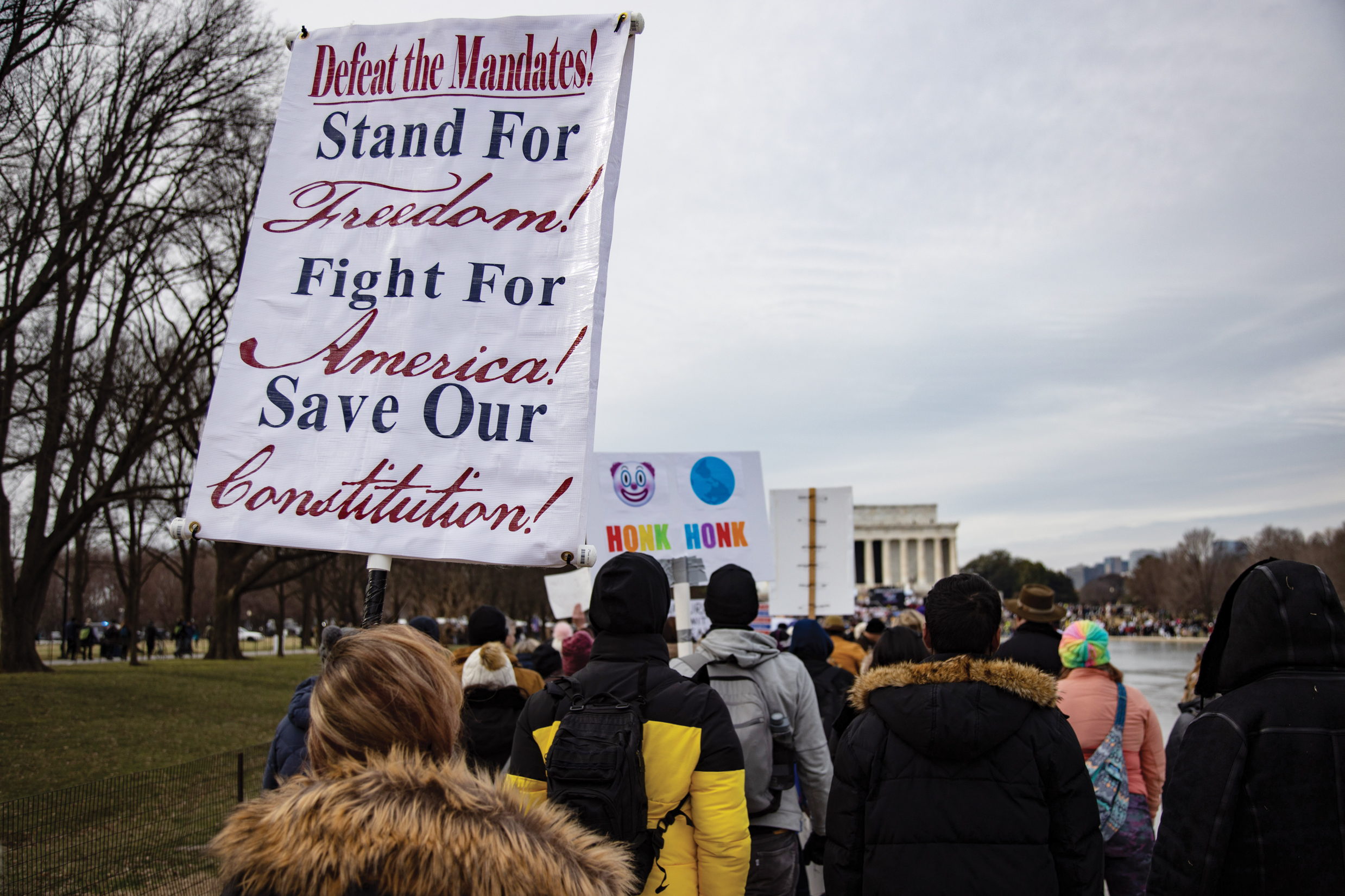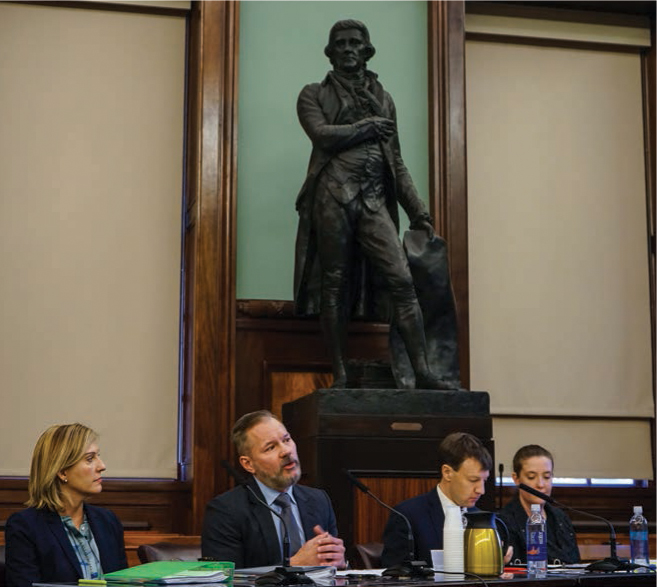Ratification of the Constitution Was Difficult
Differentiate between the Federalists’ and Antifederalists’ stances on the ratification of the Constitution
The first hurdle faced by the proposed Constitution was ratification by state conventions of delegates elected by voters. This struggle for ratification included 13 separate state campaigns, each influenced by local as well as national considerations.
Two sides faced off in all the states, calling themselves Federalists and Antifederalists (see Table 2.3). The Federalists (who more accurately could have called themselves “Nationalists”) supported the Constitution and preferred a strong national government. The Antifederalists opposed the Constitution and preferred a more decentralized federal system. The Federalists were united in their support of the Constitution, whereas the Antifederalists were divided over possible alternatives.
Federalists and Antifederalists Fought Bitterly over the Wisdom of the New Constitution
Thousands of essays, speeches, pamphlets, and letters were presented for and against ratification of the proposed Constitution. The best-known pieces in support were the 85 articles published in New York City newspapers by Alexander Hamilton, James Madison, and John Jay. These Federalist Papers, as they are known today, defended the principles of the Constitution and sought to dispel fears of a strong national government. Meanwhile, the Antifederalists, including Patrick Henry and Richard Henry Lee, argued in their speeches and writings that the new Constitution betrayed the Revolution and was a step toward monarchy.
Representation
One major area of contention between the two sides was the nature of political representation. The Antifederalists asserted that representatives must be “a true picture of the people . . . [possessing] the knowledge of their circumstances and their wants.”26 This could be achieved, they argued, only in small republics such as each of the existing states, whose people were relatively similar to one another. In their view, the size and diverse population of the entire nation made a truly representative form of government impossible.
Federalists saw no reason that representatives should be exactly like those they represented. In their view, one of the great advantages of representative government over direct democracy was precisely the possibility that the people would choose individuals with experience and talent greater than their own to represent them. In Madison’s words, rather than mirroring society, representatives must be “[those] who possess [the] most wisdom to discern, and [the] most virtue to pursue, the common good of the society.”27
|
TABLE 2.3 Federalists versus Antifederalists |
||
|
FEDERALISTS |
ANTIFEDERALISTS |
|
|
Who were they? |
Property owners, creditors, merchants |
Small farmers, frontiersmen, debtors, shopkeepers, some state government officials |
|
What did they believe? |
Believed that elites were most fit to govern; feared “excessive democracy” |
Believed that government should be closer to the people; feared concentration of power in hands of the elites |
|
What system of government did they favor? |
Favored strong national government; believed in “filtration” so that only elites would obtain governmental power |
Favored retention of power by state governments and protection of individual rights |
|
Who were their leaders? |
Alexander Hamilton, James Madison, George Washington |
Patrick Henry, George Mason, Elbridge Gerry, George Clinton |
Tyranny
A second issue dividing Federalists and Antifederalists was the threat of tyranny—unjust rule by the group in power. The two sides, however, had different views of the most likely source of tyranny, and thus different ideas about how to keep it from emerging.
For the Antifederalists, the great danger was the tendency of republican governments to become gradually more “aristocratic,” with members of the small group in authority using their positions to gain more and more power over other citizens. In essence, Antifederalists feared the few would tyrannize the many. For this reason, they sharply criticized those features of the Constitution that created governmental institutions without direct responsibility to the people—such as the Senate, the presidency, and particularly the federal judiciary, with its lifetime appointments.
The Federalists, in contrast, viewed the danger particularly associated with republican governments not as aristocracy but as tyranny over the few by the many. They feared that a popular majority, “united and actuated by some common impulse of passion, or of interest, adverse to the rights of other citizens,” would “trample on the rules of justice.”28 From their perspective, those features of the Constitution that the Antifederalists attacked as potential sources of tyranny actually offered the best hope of preventing it. They saw the nation’s size and diversity as further protection because these characteristics would make it harder to unite a tyrannical majority.
Governmental Power
A third divisive issue concerned how to place limits on governmental action. Antifederalists favored limited government and proposed limiting and spelling out the powers granted to the national government in relation both to the states and to the people at large. To them, its powers ought to be “confined to certain defined national objects”29 so that it did not “swallow up all the power of the state governments.”30 Antifederalists bitterly attacked the supremacy and elastic clauses of the Constitution as dangerous surrenders of power to the national government.31 They also demanded that a bill of rights be added to the Constitution to limit the government’s power over the people.

In reply, Federalists such as Hamilton acknowledged the possibility that every power could be abused, but argued that the risk was worth taking in order to give the government the powers needed to achieve essential national goals. In addition, the various checks and controls on power incorporated into the Constitution would minimize the risks of abuse. As Madison put it, “the power surrendered by the people is first divided between two distinct governments (state and national), and then the portion allotted to each subdivided among distinct and separate departments. Hence, a double security arises to the rights of the people. The different governments will control each other, at the same time that each will be controlled by itself.”32 The Federalists’ concern with avoiding unwarranted limits on governmental power led them to oppose a bill of rights as unnecessary.
Compromise Contributed to the Success of the New System
While the Federalists ultimately prevailed, the Antifederalists had a lasting impact on the Constitution by making a persuasive case for the inclusion of a bill of rights. During the first Congress, in June 1789, Madison introduced a proposed bill of rights. Three months later, Congress sent a final list of amendments to the states, and in December 1791 the states ratified the Bill of Rights—the first 10 amendments to the Constitution. Intended to protect individual rights and liberties from government overreach, these include the freedom of speech, the right to bear arms, protection from unreasonable searches, and the right to a fair trial. Initially, the amendments applied only to the federal government; not until passage of the Fourteenth Amendment in 1868 were many of the protections extended to states. At the end of the ratification fight, the Federalists did secure passage of the Constitution, and the compromise around a bill of rights made for a stronger governing document—one that has endured to the present. (We’ll say more about the Bill of Rights in Chapter 4.)
WHAT DO YOU THINK?
THE CONSTITUTION

Many Americans cherish the nation’s founding documents as symbols of the great American “experiment for pro moting human happiness,”33 as George Washington termed it. But the system of government that emerged was the subject of intense debate and of com promise between competing factions with differing interests along regional, economic, and philosophical lines. The meaning of the values encapsulated in the institutions of American government as set out in the Constitution were the subject of debate as well—and continue to be contested to this day.
The Founders placed individual liberty ahead of all other political values. They feared that too much democracy could degenerate into tyranny of the majority. They feared that economic or social equality would inspire the have-nots to interfere with the liberty of the haves. As a result, they designed many of the Constitution’s key provisions, such as separated powers, internal checks and balances, and federalism, to safeguard liberty, and they designed others, such as indirect election of senators and the president and the appointment of judges for life, to limit democracy and the threat of majority tyranny. These features continue to influence the nature of representation in the United States.
By championing liberty, however, the framers virtually guaranteed that the fight for justice and equality would mark the history of the United States. The degree to which different groups of Americans have enjoyed liberty, equality, and justice has varied across time and place. But because liberty promotes political activity and participation, it encourages people and groups to fight for their rights and interests and for justice. In so doing, they may achieve greater equality.
- What do you think about the values of liberty, equality, and justice? Which is most important to you? Which do you think is most important to New York City council member Inez Barron, or Professor Sean Wilentz? How might your life be different if you lived in a country with different commitments to these values?
- Advocates arguing for a particular policy position often invoke cherished values such as liberty, equality, and justice to support their positions. What kinds of arguments could both supporters and opponents of removing statues of the nation’s Founders make using these three values?
- Are there policy areas where you are frustrated by the slow policy-making process created by the separation of powers and the system of checks and balances? Or policy areas where you are relieved that changes that you opposed were slowed or halted? What are your views on the pros and cons of the nation’s constitutional structure?
Use  to help you study and master this material.
to help you study and master this material.
Glossary
- Federalists
- those who favored a strong national government and supported the Constitution proposed at the American Constitutional Convention of 1787
- Antifederalists
- those who favored strong state governments and a weak national government and who were opponents of the Constitution proposed at the American Constitutional Convention of 1787
- Federalist Papers
- a series of essays written by Alexander Hamilton, James Madison, and John Jay supporting ratification of the Constitution
- tyranny
- oppressive government that employs cruel and unjust use of power and authority
- limited government
- a principle of constitutional government; a government whose powers are defined and limited by a constitution
Endnotes
- Melancton Smith, quoted in Herbert J. Storing, What the Anti-Federalists Were For (Chicago: University of Chicago Press, 1981), 17. Return to reference 26
- Federalist Papers, no. 57. Return to reference 27
- Federalist Papers, no. 10. Return to reference 28
- “Essays of Brutus,” no. 7, in Herbert J. Storing, The Complete Anti-Federalist (Chicago: University of Chicago Press, 1981). Return to reference 29
- “Essays of Brutus,” no. 6, in Storing, Complete Anti-Federalist. Return to reference 30
- Storing, What the Anti-Federalists Were For, 28. Return to reference 31
- Federalist Papers, no. 51. Return to reference 32
- George Washington to Catharine Macaulay Graham, Letter, “A Great Experiment,” January 9, 1790. Return to reference 33